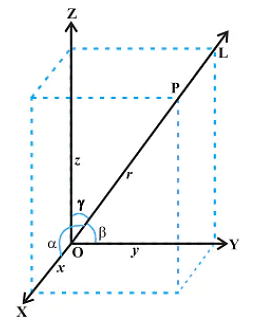Let the lines\( \begin{array}{l} \frac{x-1}{\lambda}=\frac{y-2}{1}=\frac{z-3}{2}\ \text{and}\ \frac{x+26}{-2}=\frac{y+18}{3}=\frac{z+28}{\lambda}\end{array}\)be coplanar and P be the plane containing these two lines. Then which of the following points does NOT lie on P?
- (0,-2,-2)
- (-5,0,-1)
- (3,-1,0)
- (0,4,5)
The Correct Option is D
Solution and Explanation
Given,\(\begin{array}{l} L_1:\frac{x-1}{\lambda}=\frac{y-2}{1}=\frac{z-3}{2},\end{array}\)through a point\(\begin{array}{l} \overrightarrow{a}_1\equiv \left(1, 2, 3\right)\end{array}\)parallel to \(\begin{array}{l} \overrightarrow{b}_1\equiv \left(\lambda, 1, 2\right)\end{array}\)
and \(\begin{array}{l} L_2:\frac{x+26}{-2}=\frac{y+18}{3}=\frac{z+28}{\lambda} \end{array}\)through a point\(\begin{array}{l} \overrightarrow{a}_2=\left(-26,-18,-28\right)\end{array}\)parallel to\(\begin{array}{l} \overrightarrow{b}_2=\left(-2,3,1\right) \end{array}\)
If lines are coplanar then, \(\begin{array}{l} \left(\overrightarrow{a}_2-\overrightarrow{a}_1\right)\cdot\overrightarrow{b}_1\times\overrightarrow{b}_2=0\end{array}\)
\(\begin{array}{l} \Rightarrow\ \begin{vmatrix}27 & 20 & 31 \\\lambda & 1 & 2 \\-2 & 3 & \lambda \\\end{vmatrix}=0\Rightarrow \lambda =3\end{array}\)
Vector normal to the required plane \(\begin{array}{l} \overrightarrow{n}=\overrightarrow{b}_1\times \overrightarrow{b}_2\end{array}\)
\(\begin{array}{l} \Rightarrow\ \overrightarrow{n}=\begin{vmatrix}\hat{i} & \hat{j} & \hat{k} \\3 & 1 & 2 \\-2 & 3 & 3 \\\end{vmatrix}=-3\hat{i}-13\hat{j}+11\hat{k}\end{array}\)
Equation of plane\(\begin{array}{l} \equiv\left(\left(x-1\right),\left(y-2\right),\left(z-3\right)\right)\cdot\left(-3,-13,11\right)=0\end{array}\)
\(\begin{array}{l} \Rightarrow 3x+13y-11z+4=0 \end{array}\)
From given option (0, 4, 5) does not lie on the plane.
Top Questions on Three Dimensional Geometry
- If A(2,1,-1), B(6,-3,2), C(-3,12,4) are the vertices of a triangle ABC and the equation of the plane containing the triangle ABC is $53x+by+cz+d=0$, then $\frac{d}{b+c}=$
- TS EAMCET - 2025
- Mathematics
- Three Dimensional Geometry
- If $(\alpha, \beta, \gamma)$ is the foot of the perpendicular drawn from a point $(-1,2,-1)$ to the line joining the points $(2,-1,1)$ and $(1,1,-2)$, then $\alpha+\beta+\gamma=$
- TS EAMCET - 2025
- Mathematics
- Three Dimensional Geometry
- If m:n is the ratio in which the point $\left(\frac{8}{5}, \frac{1}{5}, \frac{8}{5}\right)$ divides the line segment joining the points (2,p,2) and (p,-2,p) where p is an integer then $\frac{3m+n}{3n}=$
- TS EAMCET - 2025
- Mathematics
- Three Dimensional Geometry
- Let $\pi_1$ be the plane determined by the vectors $\hat{i}+\hat{j}, \hat{i}+\hat{k}$ and $\pi_2$ be the plane determined by the vectors $\hat{j}-\hat{k}, \hat{k}-\hat{i}$. Let $\vec{a}$ be a non-zero vector parallel to the line of intersection of the planes $\pi_1$ and $\pi_2$. If $\vec{b} = \hat{i}+\hat{j}-\hat{k}$ then the angle between the vectors $\vec{a}$ and $\vec{b}$ is
- TS EAMCET - 2025
- Mathematics
- Three Dimensional Geometry
Show that the following lines intersect. Also, find their point of intersection:
Line 1: \[ \frac{x - 1}{2} = \frac{y - 2}{3} = \frac{z - 3}{4} \]
Line 2: \[ \frac{x - 4}{5} = \frac{y - 1}{2} = z \]
- CBSE CLASS XII - 2025
- CBSE Compartment XII - 2025
- Mathematics
- Three Dimensional Geometry
Questions Asked in JEE Main exam
Nature of compounds TeO₂ and TeH₂ is___________ and ______________respectively.
- JEE Main - 2025
- Inorganic chemistry
- Let \( A = [a_{ij}] \) be a matrix of order 3 \(\times\) 3, with \(a_{ij} = (\sqrt{2})^{i+j}\). If the sum of all the elements in the third row of \( A^2 \) is \( \alpha + \beta\sqrt{2} \), where \(\alpha, \beta \in \mathbb{Z}\), then \(\alpha + \beta\) is equal to:
- JEE Main - 2025
- Matrices and Determinants
Consider the following sequence of reactions :

Molar mass of the product formed (A) is ______ g mol\(^{-1}\).- JEE Main - 2025
- Organic Chemistry
The magnitude of heat exchanged by a system for the given cyclic process ABC (as shown in the figure) is (in SI units):

- JEE Main - 2025
- Electric charges and fields
- The value of \( (\sin 70^\circ)(\cot 10^\circ \cot 70^\circ - 1) \) is:
- JEE Main - 2025
- Trigonometric Identities
Concepts Used:
Three Dimensional Geometry
Mathematically, Geometry is one of the most important topics. The concepts of Geometry are derived w.r.t. the planes. So, Geometry is divided into three major categories based on its dimensions which are one-dimensional geometry, two-dimensional geometry, and three-dimensional geometry.
Direction Cosines and Direction Ratios of Line:
Consider a line L that is passing through the three-dimensional plane. Now, x,y and z are the axes of the plane and α,β, and γ are the three angles the line makes with these axes. These are commonly known as the direction angles of the plane. So, appropriately, we can say that cosα, cosβ, and cosγ are the direction cosines of the given line L.
